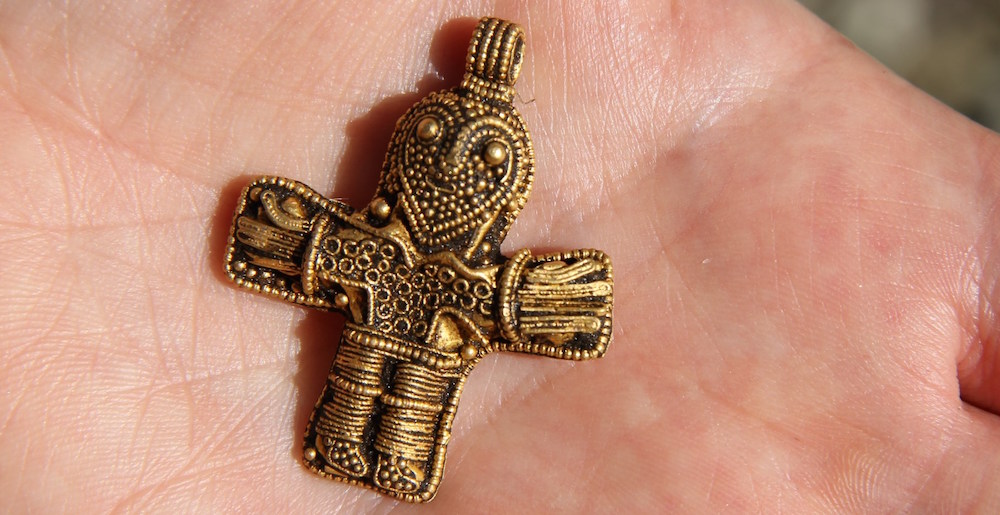
A solid-gold cross depicting Jesus with his arms outstretched may be Denmark's oldest crucifix, dating back more than 1,100 years.
The gorgeous pendant was unearthed in March by a hobbyist with a metal detector. Found in a field on the island of Funen, Denmark, the Viking jewelry piece may have been worn by a Viking woman, according to the Viking Museum at Ladby, where the pendant was on display.
"It's a completely sensational find that dates back to the first half of the 900s," Malene Refshauge Beck, a curator and archaeologist at Østfyns Museum, told the Danish newspaper DR Nyheder. "This object will definitely need to figure in future history books as it could alter the period when it is believed that Danes became Christian." [Fierce Fighters: 7 Secrets of Viking Seamen]
Fruitful day off work
The stunning find was pure chance. Dennis Fabricius Holm, a metal detector hobbyist living in Aunslev, Denmakr, was enjoying a few hours off work by doing scouting in the empty field outside a medieval church. He encountered a gold pendant, and posted a photo of it to social media, where others suggested he contact an archaeologist, he told the Danish newspaper.
"I got off early on Friday, so I took just a few hours, I went around with my metal detector and then I came suddenly on something," Holm told DR Nyheder. "Since I cleared the mud and saw the jewelry, I have not been able to think of anything else."
The Viking bling is about 1.6 inches (4.1 cm) long and shows a man with outstretched arms. The Jesus figure is crafted out of filigree gold pellets and gold thread and weighs 0.46 ounces (13.2 g). The weighty cross likely belonged to a wealthy woman, though it's not clear whether the woman was Christian or whether a pagan Viking was showing some stolen goods, according to the museum.
Sign up for the Live Science daily newsletter now
Get the world’s most fascinating discoveries delivered straight to your inbox.
Rare find
The Viking trinket is rare in a number of ways. It's unusual to find such a delicate and expensive piece of jewelry intact in an open field. While archaeologists had found fragments of crosses in Viking burial ships, those dated to later periods, were made of silver and were smaller that this discovery. A very similar cross, dating to about the same time period, however, was found in Sweden.
Dating to the first half of the 10th century, the new find predates the A.D. 965 Jelling Stones, which include Harald Bluetooth's rune stone. That stone, which tells of King Harald's conversion of the Danes to Christianity, was previously thought to be the oldest depiction of Christ on a cross in Denmark.
The medieval church near the field dates to the 1200s, but other rare objects, such as a rune stone, have been unearthed in the area before, according to a statement. That suggests the church may have been founded near an ancient Viking settlement.
The new find pushes back the date at which Christianity entered the region, Beck said.
"Over the last few years there have been more and more signs that Christianity was spread earlier than previously thought – and up until now, this find is the clearest proof of that," Beck told DR Nyheder.
The popular conception is that manly Viking pirates pillaged and terrorized Europe for centuries before converting to Christianity and settling down to a sober life of praying, farming and churchgoing in the 11th century. Over the last several decades, archaeologists and historians have realized the reality was much more complicated. For instance, most Vikings were only part-time pirates and had day jobs as farmers. Viking women came along on adventures, too. And many Vikings didn't simply loot and run, but established far-flung urban centers that are still occupied today, such as the city of Dyfflin, or Dublin, which was founded by Vikings.
The new find was on display during the Easter season at the Viking Museum at Ladby, but has since been sent for preservation work, according to the statement.
Follow Tia Ghose on Twitter and Google+. Follow Live Science @livescience, Facebook & Google+. Original article on Live Science.

Tia is the managing editor and was previously a senior writer for Live Science. Her work has appeared in Scientific American, Wired.com and other outlets. She holds a master's degree in bioengineering from the University of Washington, a graduate certificate in science writing from UC Santa Cruz and a bachelor's degree in mechanical engineering from the University of Texas at Austin. Tia was part of a team at the Milwaukee Journal Sentinel that published the Empty Cradles series on preterm births, which won multiple awards, including the 2012 Casey Medal for Meritorious Journalism.









